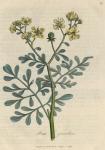
 Synonyma. Ruta. Pharm. Lond. & Edinb.
Synonyma. Ruta. Pharm. Lond. & Edinb.
Ruta hortensis. Gerard, emac. p. 1255.
Ruta hortensis major. Park. Theat. p. 132.
Ruta sativa vel hortensis. Bauh. Hist. iii. p. 197.
Ruta hortensis latifolia. Bauh. Pin. p. 336. Raii Hist. p. 874.
Ruta foliis duplicato-pinnatis, lobulis ovatis. Hal. Stirp. Helv. No. 1003.
(greek) seu (greek) Graec.
Class Decandria. Ord. Monogynia. L. Gen. Pl. 523.
Ess. Gen. Ch. Cal. 5-partitus. Petala concava. Receptac. punctis melliferis decern cinctum. Caps, lobata. Quinta pars numeri in quibusdam excluditur.
Spec. Char. R. foliis decompositis, floribus lateralibus quadrifidis.
The root sends forth several shrubby stalks, which towards the bottom are strong, woody, and covered with rough, grey, striated bark; the upper or young branches are smooth, and of a pale green colour: the leaves are compound, consisting of double sets of irregular pinnae, which are minutely notched or crenulated, of an obversely oval shape, and of a glaucous or bluish green colour: the flowers are numerous, and produced in a branched corymbus on subdividing peduncles: the calyx commonly divides into four and sometimes into five pointed leaves; the corolla consists of four and frequently of five petals, these are hollow or boat-shaped, dentated or fringed at the edges, and of a yellow colour; the ten filaments are yellow, tapering, spreading, and generally lodged in the cavity of the petals; the antherae are yellow and quadrangular; the style is short; the stigma is simple; and the germen is large, oval, green, rough, and marked by four longitudinal furrows; the seeds are angular, rough, and of a blackish colour. This shrub is a native of the South of Europe, and flowers in June and September.
The first account we have of the cultivation of Rue in Britain, is given by Turner, who published his Herbal in 1562. [Vide Hort. Kew.] It is now extremely common in our gardens, where it retains its verdure the whole year. Rue has a strong ungrateful smell, and a bitter, hot, penetrating taste; the leaves are so acrid, that by much handling they are said to irritate and inflame the skin; and the plant, in its natural or uncultivated state, is reported to possess these sensible qualities still more powerfully. Both water and rectified spirit extract its virtues, but the latter more perfectly than the former. [From the experiments of Beaumé it appears, that the recent plant contains but a very small portion of essential oil: thus from 21 lb. of the leaves he scarcely obtained a dram, while 10 lb. of the seeds yielded two ounces. Berg. M. M. p. 350.]
Rue was much used by the ancients, who ascribed to it many virtues. Hippocrates commends it as a resolvent and diuretic, and attributes to it the power of resisting the action of contagion, and other kinds of poisons, and with this intention it was used by Mithridates: [In sanctuariis Mithridatis maximi regis devicti, Cn. Pompeius invenit, in peculiari commentario ipsius manu, compositionem antidoti, e duabus nucibus siccis, item sicis totidem & ruta; foliis viginti simul tritis, addito salis grano: & qui hoc jejunus sumat, nullum venenum nociturum illo die. Plin. L. 23. c. 8. p. 604.] this imaginary quality ["One virtue particularly ascribed to Rue, that of resisting contagion, or of expelling it when taken in, I hold to be absolutely without foundation."—Cullen M.M.v.2 p. 365.] of the Ruta, is now however very little credited, though so highly extolled by Boerhaave. [The opinion formerly entertained of this plant, may be collected from the Schola Salernitana, in which its virtues are thus celebrated, c. 37. p. 427.
Nobilis est ruta, quia lumina reddit acuta;
Auxilio rutae, vir lippe videbis acute;
Cruda comesta recens, oculos caligine purgat.
Ruta viris minuit Venerem, mulieribus addit.
Ruta facit castum, dat lumen, & ingerit astum,
Cocta & facit ruta de publicibus loca tuta.]
According to Bergius it is "alexiteria, pellens, emmenagoga, sudorifera, rubifaciens." It is doubtless a powerful stimulant, and may be considered, like other medicines of the fetid kind, to have attenuating, deobstruent, and antispasmodic powers, ["I have no doubt in asserting its antispasmodic powers." Cullen M. M. v. 2. p. 365.] and to be more peculiarly adapted to phlegmatic habits, or weak and hysterical constitutions, suffering from retarded or obstructed secretions. In the London Pharm. Ruta is directed in the form of an extract, and it is also an ingredient in the Pulvis e myrrha compositus. By some it is employed in the way of tea.

